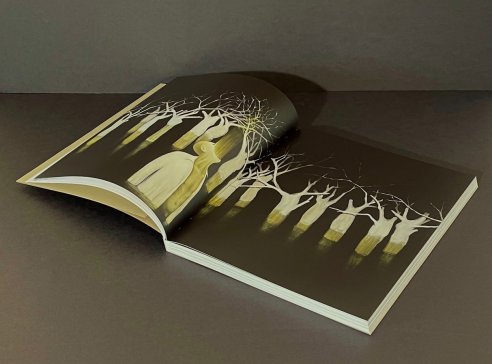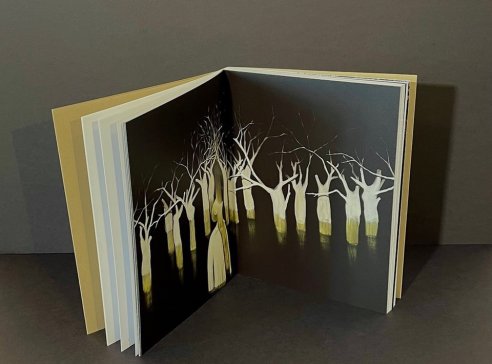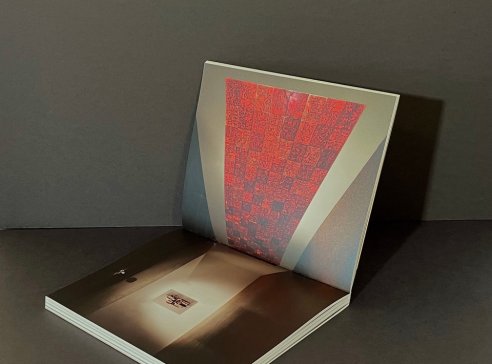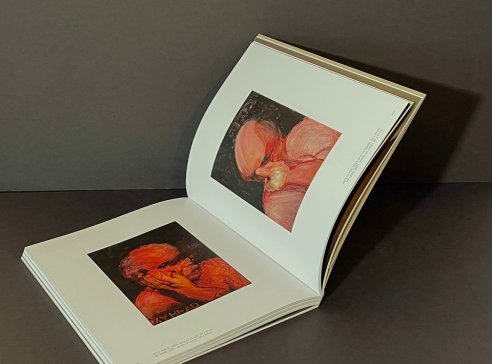Publications › Daniel Pešta: Big Bang
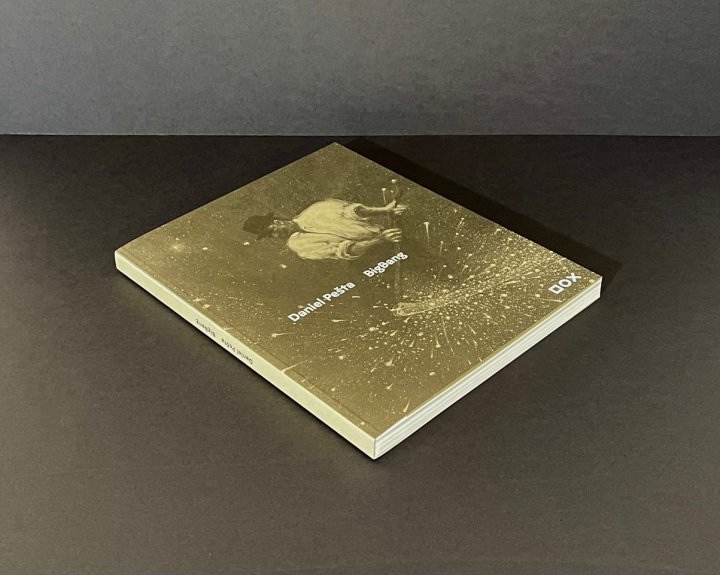
In its own way every historical era is unique. Some are remembered as a time when civilisation flourished, others, on the other hand, brought with them dark testimonies… So begins Daniel Pešta’s introduction to this book in which he has summed up his work of recent years. It is precisely the ephemeral character of the era formed by countless component events in science, politics and art, and also echoes from the past and the expectations placed in the future, the flutter of butterfly wings that will cause a tempest at the far end of the world… we can call this Pešta’s long-term theme. At the same time it does not attempt to document objective facts, but rather to portray their symbolic meaning, to record what is “in the air” – worries, forebodings, hopes and beliefs, stereotypes, passions and animosities that comply with the content of the concept “the climate of the time”. It is difficult for us to find another period in history with such a clearly defined common denominator for the whole of global society as the Covid 19 pandemic. Not since World War Two has anything so shaken the very foundations of Western civilisation, challenged its direction, exposed its dystopia and submitted a bill for its sins. It is precisely at this time that Daniel Pešta creates a free cycle with the ambiguous (how else) name Big Bang, in which he has intimated the causes and circumstances of civilisation’s fatal crisis and heralding its consequences. In this way he has confirmed that he belongs among the voyants – seeing or visionary artists passing on messages and warnings which are not always well understood in their time…
Daniel Pešta’s creative process has much in common with meditation. He works in silence, alone, in absolute concentration and in “connection” to existence in its entirety. The ego retreats into the background and he becomes a kind of medium, a “go-between“ for information, which he has the task of translating into convincing visual language. To do this, he uses a wide range of artistic means: he expresses himself through painting – in which he freely crosses over from realistic record through symbolist abbreviation to expressive, gestural expression – photographs, collages, assemblages, spatial objects and also video-art.
Film grammar, which stratifies images (as well as sounds) into a storyline, has inspired Pešta for over ten years – enabling him to develop contents, implied in the second and third dimension in paintings and objects, into a fourth dimension. One of the latest video-arts Řetěz – Chain (which he introduced in 2018 at his retrospective exhibition DeTermination at the DOX Centre for Contemporary Art and later presented as part of the collateral project of the Venice Biennale Personal Structures), we see from today’s perspective as a chilling vision of the present. Remember its storyline: In the middle of a devastated industrial building men in white shirts sit round a table on which candles are burning. One of the men extends his gauze-wrapped hands above one of the candles. A flame flares up, the gauze ignites, the man stretches a burning hand towards his neighbour who takes over the fiery relay-baton, passing it on in no time to the next person who, in turn, hands it over to the next. Not a hint of defiance, not a shadow of a doubt, not even a single question. Just blind obedience, the automatic compliance with an order. Only when the flame begins to spread to their sleeves do the men start to throw their arms wildly about in panic, extinguishing the flame at the very last moment.
Although we can see the metaphor for viral infection in the flaming relay, it is more likely that it is about a mental contamination – about the thoughtless following of set patterns and acceptance of given values which can lead to the destruction not only of the individual but of civilisation itself. Maybe it is a blind faith in authority, maybe a reluctance to think for oneself, maybe a worry about losing one’s position in society and fear of standing out from the crowd, or simply the feeling of comfort that slowly but surely leads a person to the edge of the abyss.
In his previous cycles Daniel Pešta concentrated on social and political matters above all. He explored the determination of a person by his racial origins, gender or social status, he dealt thoroughly with collective guilt, the anonymity of the crowd and its political manipulation. In the catalogue of his retrospective exhibition DeTermination, which took place at DOX in 2018, the following sentence is recorded: “History has often showed that one of the most effective ways in which to control the masses is by evoking fear in them and then offering up oneself as their protector. However, the threatened danger in most cases does not normally exist at all and so it is neccesary to create it artificially.“ Not only this prophetic declaration but also the surreal scenes from the cycle Recordings of the Night Head, Hell, Seekers of Light, School in Nature (ZeasdHHHáznamy noční hlavy, Peklo, Hledači světla, Škola v přírodě) and the video-arts Out of Nowhere (Odnikud nikam) all materialised in the “covid era“ with chilling precision… It could be suggested that the author just develop his older work further, placing it in the current context. But that would not be a great enough challenge to Pešta. In his reflections he does not skate over the surface of a phenomenon, but seeks out its deeply sown seeds. His central theme now becomes enviromental issues.
During lockdown, walks in parks and forests became the only possible escape and so – perhaps for the first time in his life – Daniel Pešta decided to paint nature. His paintings, however, do not portray bucolic landscapes from the Slapy waterside, nor romantic scenes from Petřín park – a post-apocalyptic landscape appears, in which all that remains from the trees – symbols of life – are dead torsoes. Amidst the stumps emerging from the endless swamp the figure of a man in a white shirt is wading – a man without a name, without any features, without attributes and without opinions – the worshipper of idols of affluence and sustainable development at all costs, ready to make sacrifices on the altar. It is the very same man who, in his panic, thrashed about with his arms in the video-art Chain (Řetěz), cut the braids of Jewish girls in Hell (Peklo), watched the extermination of Roma with satisfaction in the project I was born in your bed and every day put on a mask of loyalty in Seven Deadly Sins (Sedmi smrtelných hříších)… Ecce Homo. The same person who has once tasted an apple from the tree of knowledge cannot fail to know what he has brought about. He can only rise to the desperate cry that cuts across the universe. But now there is no-one to hear him anymore. After all God is long-dead and the propaganda “one baptism for the remission of sins“ no longer fools anyone.
The cry, the atavism, which accompanies extreme emotions serving as a warning signal or tool for coercion or intimidation, has long fascinated Daniel Pešta. In an ever-expanding series of paintings he is exploring the bipolar nature of this animal sound which could be the manifestation of pain and hopelessness, or else a demonstration of strength. It seems that the scream that the person is emitting in Pešta’s large-format painting Ecce Homo connects both opposites – it is an expression of power without any power. The Big Bang cycle may not perhaps offer a testimony to the Big Bang that gave rise to our world, but rather to that which will sound thunderously during its extinction.
The sharpened optics of the recorded catastrophic vision are, in the framework of Pešta’s bipolar work, always offset by the promise of hope, often personified in the figure of Jesus Christ, the representative of universal moral and spiritual values. While the lone man wades through the chaos that he himself has wreaked, the legion of Christs taken down from their crosses is seen wading through the blood in Memento, so as to remind us of the eternal duality of physical transcience and its spiritual transcendence. Our material and time-limited physical life is however perceived by Pešta as a gift, as a unique potential, which we have the task of accomplishing to a maximum extent and quality, and not sacrificing it for the benefit of any ideology. The act of conception is celebrated in its sensual nature and the immaculate idol of the mother of God heretically (but always without any hint of ridicule or degradation) equates with a glorified depiction of the beginning of each human life – the vagina.
Pešta’s paintings and assemblages, whose radical art form intersects with their existential content, are interspersed in this book with photographs of nature which Daniel Pešta took during the course of his daily walks over two years. Ominous skies over a ploughed field, trees stepping out of the autumn mists, a path in the park gleaming brightly with rain, the sun’s rays breaking through a curtain of storm clouds, the spring sunshine illuminating an alder grove, apple blossom bursting open, the sky above reflected on the surface of a lake, lush green overgrowth, the golden crowns of autumnal trees… What role do these photographs of a not unusual landscape in common situations play within the whole story? They document the author’s enchantment with the beauty of the landscape, its changeability… enchantment and belief in all that is roofed over, the perfect order of nature, whose indomitable vitality and in all its strength resist the impending ecological catastrophe and the other self-destructive actions of man – that insignificant evolutionary error who will itself soon erase himself from the surface of the Earth, while the majesterial spruce forests will continue to border the shores of lakes with white clouds floating on the surface. Forever.
Terezie Zemánková, October 2021
Texts: Terezie Zemánková, Daniel Pešta
Publisher: DOX Prague, a.s., Prague 2021
167 pages, ISBN: 978-80-87446-53-9

